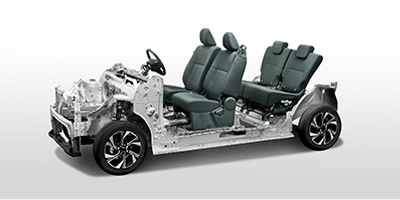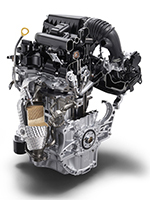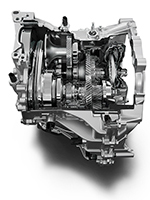- Products / Technology
- Technology
- SDGs /CSR /Environment
- NEWJun. 06, 2019
Daihatsu Announces New DNGA Technologies ~To be incorporated in the new Tanto in July, then gradually rolled out in Japan and emerging markets~
Jun. 06, 2019
Daihatsu Motor Co., Ltd.
Daihatsu Motor Co., Ltd (hereinafter “Daihatsu”) today announced new technologies based on the Daihatsu New Global Architecture (DNGA), which it will use to create a new generation of vehicles. Part one of DNGA will see these technologies incorporated in the new Tanto in July 2019, while part two of DNGA is scheduled to be released before the end of the year. Daihatsu seeks to establish DNGA as the standard for the next generation of its mini vehicles and compact cars both in Japan and emerging markets.
Daihatsu implemented collective planning and development and updated all elements of its platform including the powertrains in order to ensure that the new technologies would be compatible with CASE*1, while at the same time rapidly expanding its product line-up..
Going forward, Daihatsu intends to use the new DNGA technologies in all its new models and thereby provide its customers with three new values: “high quality at affordable prices,” “mastering the smallest details,” and “providing advanced technologies to everyone.” Through safety, peace of mind, and comfort, the company aims to make its customers’ lives and societies richer and more energetic.
Overview of the new DNGA technologies
◆ Adoption of “collective planning and development,” through which mini and small vehicles share the same design concepts
◆ Realization of three evolutions: “vehicle evolution,” “powertrain evolution,” and “advanced safety technology evolution”
◆ Incorporation of “CASE-compatible design concepts,” such as the future realization of connected services and electrification



※1: Connected、Autonomous、Shared、Electric
Adoption of “collective planning and development,” through which mini and small vehicles share the same design concepts
- Using Daihatsu’s previous platform and at its previous development speed, it would have been difficult both to comply with CASE and to swiftly launch products in emerging markets, where competition is expected to become increasingly fierce. For this reason, after mastering the “smallest details” in its mini vehicles, the company has chosen to develop a new platform which incorporates “collective planning and development,” through which mini and small vehicles share the same design concepts.
- Daihatsu re-designed the size and position of various parts—including the position of the engine and suspension, the design of the framework, and the position of the seats—so that they could be shared by all vehicles; the performance and specifications were then planned in a collective manner. Going forward, all new Daihatsu models will be based on this design concept and thus share similar forms. This will lead both to high quality at affordable prices and to greater development efficiency.
- In order to provide its customers with safety, peace of mind, and comfort, Daihatsu defined the performance goals of the new platform to be “class-beating stability and comfort.” Seeking to find an optimal placement of parts, which would enable the company to achieve its performance goals without increasing costs, all elements of the platform—including the suspension, underbody, engine, transmission, and seats—were re-developed from scratch and updated at the same time.
- By applying collective planning and development to these parts re-development activities, Daihatsu has succeeded in ensuring that 75 percent of parts are shared by all its mini vehicles and compact cars; going forward, this will enable products to be delivered in a timely manner.
- Collective planning and development has increased the speed with which new models can be launched by approximately 50 percent. Based on this new platform, Daihatsu intends to release 15 body types and 21 models by the end of 2025.
Realization of three evolutions: “vehicle evolution,” “powertrain evolution,” and “advanced safety technology evolution”
Vehicle evolution
Newly developed suspension
- Daihatsu’s development of the new platform started with the suspension. By designing a new suspension geometry that prioritized stability and comfort, the company has succeeded in optimizing vehicle behavior and controlling input from road surfaces
- The structure of the chassis parts was rationalized to create this optimal suspension geometry and, by reducing the total number of parts, the company also succeeded in making the chassis lighter
Newly developed underbody
- The front and rear force application points receive input from the suspension—by smoothly joining the spaces between the force application points, and by increasing the rigidity of the underbody, Daihatsu succeeded in optimizing the suspension’s responsiveness. The frame of the underbody had also been smoothened so that it will respond rationally to impacts; securing the underbody’s collision safety performance, strength, and NV performance for the next 10 years.
- Through rationalization of the frame, the vehicle is lighter while vertical rigidity in bending has been improved by 30%, allowing realization of a light-weight, high rigidity body.
Lightening the entire vehicle
- As part of its redesigns of the suspension and underbody structures, Daihatsu has optimized the plate thicknesses of each part and reduced the total number of parts used; in addition, 10 percent more hightensile steel is used in the upper body*3, resin parts have been incorporated, and the plate thicknesses of the outer panels and bulkhead panels have also been optimized. This has led to the weight of the whole vehicle being reduced by 80 kilograms*4.
*2 Compared to the previous Tanto
*3 The percentage of high-tensile steel used with an Mpa of 440 or more
*4 Compared to the previous Tanto. The new Tanto offsets some of the weight saved by the new framework to improve its product appeal through additional equipment; for this reason, the weight difference is not as great as 80 kilograms.
Powertrain evolution
Newly developed engine
- Daihatsu has updated all engine parts; by making improvements to combustion features, which are critical to performance, every aspect of the engine has been enhanced, including fuel efficiency, driving performance, and environmental performance.
- The engine is the first in Japan*5 to adopt a multi spark. By accelerating the combustion speed within the cylinders and by reducing knocking, EGR volumes have been increased and fuel efficiency improved.
- The size of the fuel droplets injected into the engine has been decreased; as a result, the amount of fuel that adheres to the ports and the combustion chamber has been reduced, and the ratio of fuel directly entering the cylinders has been increased. In addition, the use of a high tumble straight port has strengthened the vertical rotation of the air-fuel mixture inside the combustion chamber, so realizing increased combustion speed.
- The valve diameters and valve positions in both naturally aspirated engines and turbo engines have been optimized according to their respective compression ratios; this has enabled engine head and piston surface areas to be minimized, while also reducing unevenness and reducing cooling loss.
- Positioning the exhaust ports inside the engine head limits temperature reductions in the exhaust gases, so improving the purification performance of the catalysts.
Newly developed D-CVT
- By adding split gears to existing CVT belt drives, Daihatsu has succeeded in developing a world-first*5 technology that combines belt drive and gear drive for enhanced transmission efficiency.
- At high speeds, the transmission switches to belt + gear drive, which improves transmission efficiency by approximately eight percent. The gear ratio range has also been extended on both low and high sides from 5.3 to 7.3; this enables powerful and smooth acceleration at low speeds, and fuel-efficient and quiet performance at high speeds.
- Belt transmission torque has been optimized to enable the same compact-size transmission to be used in all models from mini vehicles to 1.5-liter vehicles.
*5 As of June 6, 2019, according to research carried out by Daihatsu. In contrast to belt-type continuously variable transmission, this structure enables motive force to be split and transmitted through both the belt and gears.
Advanced safety evolution
- Using knowledge accumulated through previous iterations of Smart Assist, Daihatsu has developed an independent control logic that enables the characteristics of stereo cameras to be fully utilized; this, in turn, has led to the addition of the following driving support functions to Smart Assist III:
◇ Adaptive Cruise Control with all speed tracking
Using stereo cameras to detect the speed and distance to the preceding car, the system tracks the preceding car—maintaining the same speed and distance—and controls its own speed until stopping.
◇ Smart Panorama Parking Assist
The previous Panorama Monitor system used four cameras positioned at the front, rear, left and right of the vehicle; the Smart Panorama Parking Assist system utilizes the left and right cameras to detect the white parking space lines and, in addition to providing voice and image guidance, also provides steering assistance. The driver can therefore focus on operating the gear levers and the accelerator and brake, while also confirming the safety of surrounding area; as a result, even drivers who find parking difficult can park with peace of mind. The system caters to both parallel parking and parking in a line.
◇ Lane Keep Control
The system uses stereo cameras to detect lane lines, and provides steering assistance to ensure the vehicle remains in the center of its lane.
◇ Lane Departure Prevention Function
If the vehicle begins to veer outside of its lane, the system activates a visual alert on the meter and provides steering assistance to return the vehicle to its lane.
◇ Adaptive Driving Beam
When driving with lights at high beam, if the system detects an oncoming vehicle, it automatically dims just the area occupied by the oncoming vehicle.
◇ Traffic Sign Recognition Function (No Entry)
If the stereo cameras detect a “no entry” sign, the system activates a visual alert on the meter.
◇ Erroneous Start Prevention Function with braking control (forward and backward)
In addition to limiting engine output, the new system adds braking control to prevent sudden starts.
◇ Side View Lamps
When turning left or right at night, in addition to standard headlights, the system also engages auxiliary lights which shine left and right; this brightly illuminates the direction in which the driver intends to turn.
Incorporation of “CASE-compatible design concepts,” such as the future realization of connected services and electrification
- The specifications of the engine compartment have been designed in anticipation of future electrification; the electronics platform has also been designed to anticipate evolutions in Smart Assist and the provision of connected services; in this way, the new platform has been designed to incorporate future CASE technologies. In order to “provide advanced technologies to everyone,” going forward Daihatsu intends to further accelerate development of its DNGA platform.
For customer inquiries, please visit your local Daihatsu sales company, or contact the Daihatsu Customer Call Center using the following telephone number: 0800-500-0182




